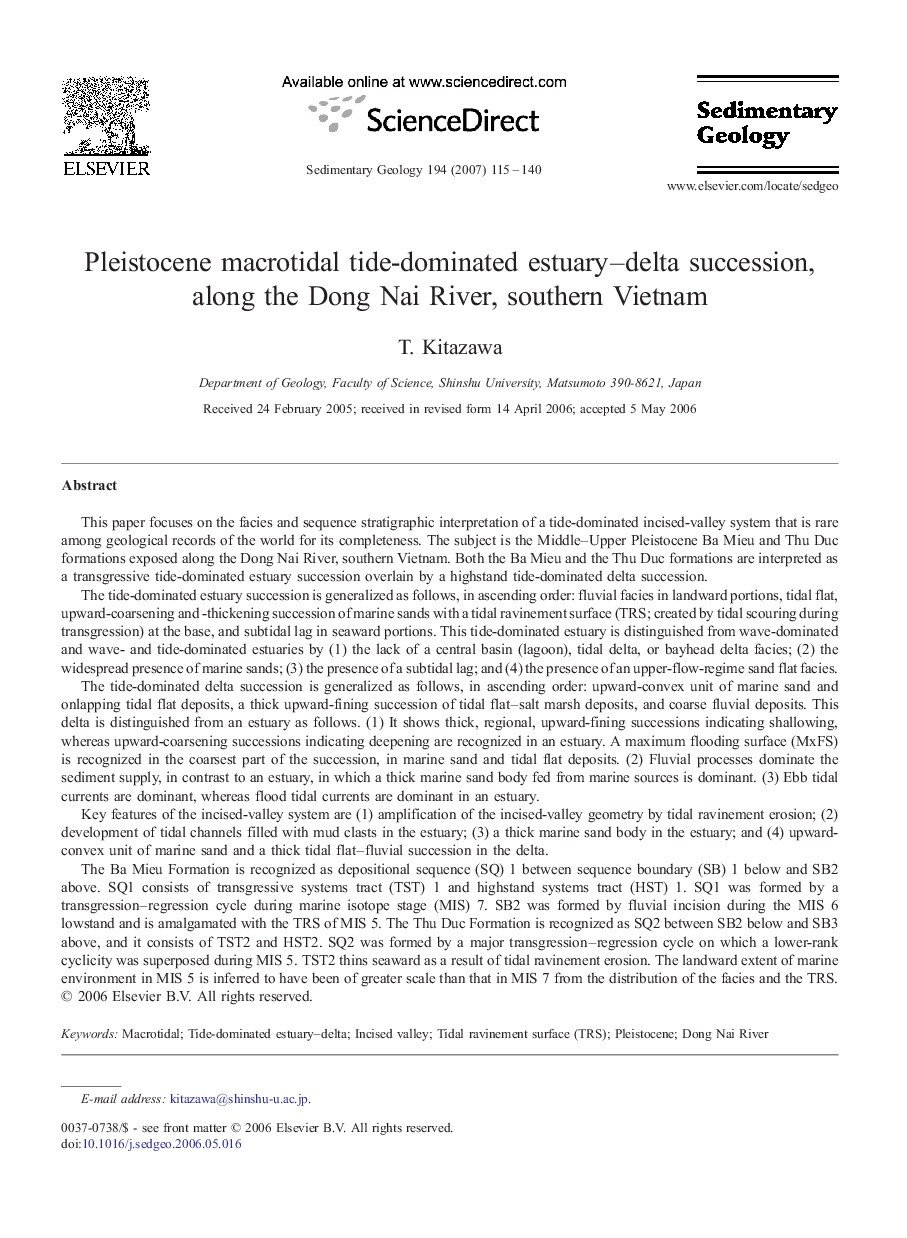| کد مقاله | کد نشریه | سال انتشار | مقاله انگلیسی | نسخه تمام متن |
|---|---|---|---|---|
| 4690901 | 1636177 | 2007 | 26 صفحه PDF | دانلود رایگان |

This paper focuses on the facies and sequence stratigraphic interpretation of a tide-dominated incised-valley system that is rare among geological records of the world for its completeness. The subject is the Middle–Upper Pleistocene Ba Mieu and Thu Duc formations exposed along the Dong Nai River, southern Vietnam. Both the Ba Mieu and the Thu Duc formations are interpreted as a transgressive tide-dominated estuary succession overlain by a highstand tide-dominated delta succession.The tide-dominated estuary succession is generalized as follows, in ascending order: fluvial facies in landward portions, tidal flat, upward-coarsening and -thickening succession of marine sands with a tidal ravinement surface (TRS; created by tidal scouring during transgression) at the base, and subtidal lag in seaward portions. This tide-dominated estuary is distinguished from wave-dominated and wave- and tide-dominated estuaries by (1) the lack of a central basin (lagoon), tidal delta, or bayhead delta facies; (2) the widespread presence of marine sands; (3) the presence of a subtidal lag; and (4) the presence of an upper-flow-regime sand flat facies.The tide-dominated delta succession is generalized as follows, in ascending order: upward-convex unit of marine sand and onlapping tidal flat deposits, a thick upward-fining succession of tidal flat–salt marsh deposits, and coarse fluvial deposits. This delta is distinguished from an estuary as follows. (1) It shows thick, regional, upward-fining successions indicating shallowing, whereas upward-coarsening successions indicating deepening are recognized in an estuary. A maximum flooding surface (MxFS) is recognized in the coarsest part of the succession, in marine sand and tidal flat deposits. (2) Fluvial processes dominate the sediment supply, in contrast to an estuary, in which a thick marine sand body fed from marine sources is dominant. (3) Ebb tidal currents are dominant, whereas flood tidal currents are dominant in an estuary.Key features of the incised-valley system are (1) amplification of the incised-valley geometry by tidal ravinement erosion; (2) development of tidal channels filled with mud clasts in the estuary; (3) a thick marine sand body in the estuary; and (4) upward-convex unit of marine sand and a thick tidal flat–fluvial succession in the delta.The Ba Mieu Formation is recognized as depositional sequence (SQ) 1 between sequence boundary (SB) 1 below and SB2 above. SQ1 consists of transgressive systems tract (TST) 1 and highstand systems tract (HST) 1. SQ1 was formed by a transgression–regression cycle during marine isotope stage (MIS) 7. SB2 was formed by fluvial incision during the MIS 6 lowstand and is amalgamated with the TRS of MIS 5. The Thu Duc Formation is recognized as SQ2 between SB2 below and SB3 above, and it consists of TST2 and HST2. SQ2 was formed by a major transgression–regression cycle on which a lower-rank cyclicity was superposed during MIS 5. TST2 thins seaward as a result of tidal ravinement erosion. The landward extent of marine environment in MIS 5 is inferred to have been of greater scale than that in MIS 7 from the distribution of the facies and the TRS.
Journal: Sedimentary Geology - Volume 194, Issues 1–2, 15 January 2007, Pages 115–140